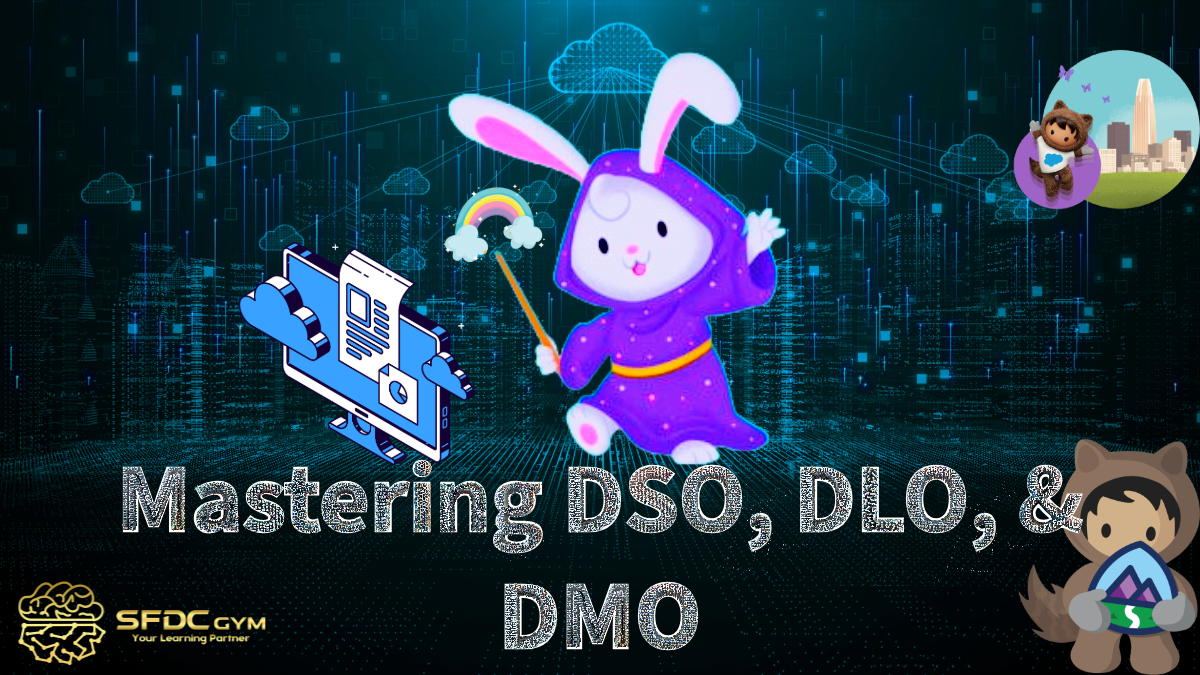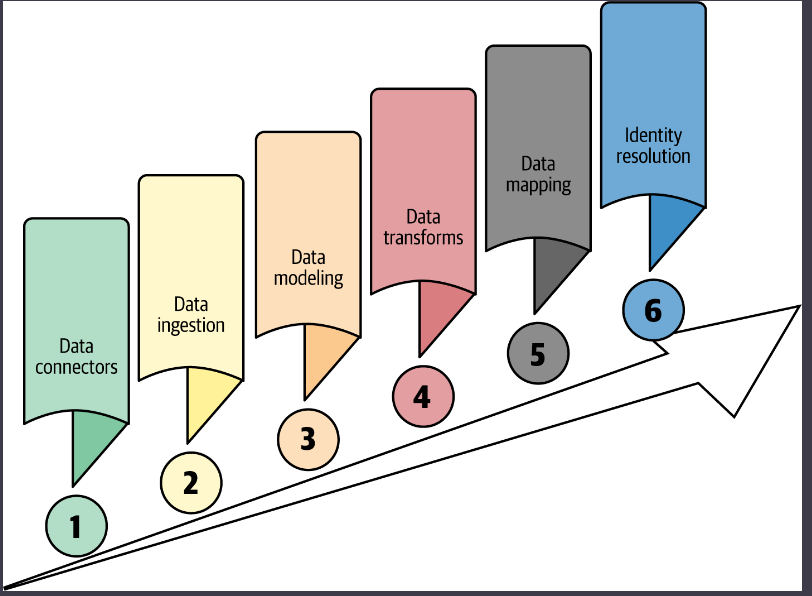Unlocking DSO, DLO, and DMO in Salesforce Data Cloud



Navigating Salesforce Data Cloud: A Complete Guide to Mastering DSO, DLO, and DMO
In today's digital age, mastering the intricacies of data management is essential for Salesforce Developers, Admins, and Data Cloud Architects. The ability to harness data effectively not only enhances decision-making but also drives business success. This guide is designed to provide you with an in-depth understanding of the foundational steps and components of Data Cloud, ensuring you can utilize data effectively from its source to the user's interface. We'll explore the essential elements, from data sources and connectors to the creation of unified profiles, offering valuable insights and practical advice.
If you are new to Data Cloud and want to understand what it is, please click on this article for a comprehensive introduction.
Connecting the Dots with Data Sources
Data sources form the backbone of any data cloud strategy. These are the origins of the data that flow into your system, enabling insights and actions. In the Salesforce ecosystem, data can be gathered from a wide variety of sources, including CRM databases, marketing platforms, and third-party applications.
Data connectors are crucial in this process, acting as the bridges that link disparate data sources to your Data Cloud. They facilitate data ingestion, allowing information to be pulled efficiently and accurately. With the right connectors, you can ensure that data is streamed seamlessly into your system, minimizing errors and delays.

Understanding the Role of Data Staging Objects (DSOs)
Once data is ingested, it temporarily resides in Data Staging Objects (DSOs). DSOs play a pivotal role in the Data Cloud, acting as temporary storage areas where incoming data is held before further processing. They are akin to holding stations, ensuring that data is organized and accessible for subsequent steps.
DSOs are essential for data modeling and transformation. They allow you to prepare your data, structuring it in a way that aligns with your analytical goals. This stage is critical for ensuring that data is accurate and ready for deeper exploration.
In addition to modeling, DSOs also facilitate data mapping. This process involves identifying relationships between different data elements and aligning them with your organizational requirements. Through effective mapping, you can ensure data consistency and reliability across the entire cloud.
The data ingestion phase is where raw data enters the Data Cloud environment. It involves extracting data from various sources and loading it into temporary storage for further processing. This step ensures that your data is ready for transformation and analysis, setting the stage for more advanced operations.
Transitioning to Data Lake Objects (DLOs)
After utilizing DSOs for staging and initial preparation, your data moves to Data Lake Objects (DLOs). Unlike DSOs, DLOs serve as persistent storage solutions within the Data Cloud. They offer a more permanent housing for your data, ensuring it is safely stored and readily available for future use.
The transition from DSOs to DLOs marks a significant step in data management. DLOs provide a robust platform for more complex operations, such as data modeling and transformation. This persistent storage is crucial for maintaining data integrity over time.
DSOs continue to play a role in these later stages, particularly in data modeling and transformation. They enable you to refine your data, ensuring it meets the specific needs of your organization. This preparation is vital for achieving accurate insights and driving informed decisions.
Delving into Data Model Objects (DMOs)
Data Model Objects (DMOs) offer a logical view of your data within the Data Cloud. They represent the structure and organization of data, providing a clear framework for analysis and reporting. DMOs are instrumental in ensuring that data is accessible and usable for business purposes.
The role of DMOs extends beyond mere organization. They facilitate the integration of data from various sources, creating a cohesive view that supports comprehensive analysis. This integration is key to deriving meaningful insights and making strategic decisions.
In the Data Cloud, DMOs serve as the blueprint for data usage. They guide how data is accessed and utilized, ensuring that it aligns with business objectives. By leveraging DMOs, organizations can optimize their data structures for maximum efficiency and impact.
The Necessity of Data Model Objects (DMOs)
DMOs are an essential component in managing and utilizing data effectively within the Data Cloud. They provide a standardized and structured way to handle data, ensuring that it can be easily accessed and interpreted.
In the context of Salesforce, identifying contacts involves using key attributes such as name, phone number, email address, or physical address. Similarly, the Data Cloud offers a variety of out-of-the-box DMOs designed to categorize and identify individuals based on these primary attributes. This standardization is crucial for creating an organized and efficient data system that supports seamless data retrieval and analysis.
By leveraging these DMOs, businesses can achieve a holistic and integrated view of their data, empowering them to make informed decisions and enhance customer relationships.

Some Important of Out-of-the-Box Data Model Objects (DMOs)
The Data Cloud offers a wide array of out-of-the-box Data Model Objects (DMOs) designed to address diverse business needs and enhance data management practices. These pre-configured DMOs provide ready-made solutions that facilitate the categorization and organization of data based on various attributes pertinent to specific industries or operational requirements. By integrating these DMOs, organizations can quickly leverage existing frameworks to streamline data processes, ensuring that their data is not only organized and accessible but also aligns with their strategic goals.
In the following section, we will explore some of the most important out-of-the-box Data Model Objects (DMOs) and their roles in enhancing data management and utilization.
Individual DMO: Contact Object
The Contact Object is a vital Data Model Object (DMO) within the Data Cloud, designed with a focus on efficiently managing individual-level data. This object captures key personal attributes, including name, phone number, email address, and physical address, which are essential for identifying and interacting with unique individuals. The use of the Contact Object not only standardizes data but also simplifies the process of data retrieval, ensuring that comprehensive profiles are readily accessible.
By adopting this DMO, organizations are better equipped to tailor their interactions and improve engagement strategies, fostering a strengthened sense of community and personalized customer service. Utilizing the Contact Object not only enhances data accuracy but also supports a connected community-centric approach, driving both business efficiency and customer satisfaction.
Contact Point Phone DMO
The Contact Point Phone DMO in the Data Cloud is an essential component for managing phone-related interactions within organizations. This DMO is specifically designed to gather and structure telephone data in a standardized format, ensuring accessibility and consistency across various platforms and departments. By implementing this model, businesses can enhance their ability to connect with customers, facilitating timely and meaningful conversations.
Moreover, the Contact Point Phone DMO supports the development of a comprehensive communication system that allows for better tracking and analysis of customer interactions via phone. This focus on phone data not only streamlines communication processes but also reinforces a community-oriented environment where customer needs are prioritized, enabling organizations to deliver supportive and knowledgeable service experiences.
Contact Point Email DMO
The Contact Point Email DMO serves as a pivotal tool for managing email communications within organizations, bringing a streamlined and structured approach to email data handling. By standardizing email information across departments, this model ensures that communication is consistent, efficient, and reflective of a unified organizational message. Implementing this DMO allows businesses to effectively track, categorize, and respond to customer inquiries, promoting a seamless communication flow.
Additionally, the Contact Point Email DMO enables organizations to harness detailed analytics pertaining to email interactions, which can be leveraged to tailor communication strategies and enhance customer engagement. This promotes a knowledgeable and supportive environment, fostering a sense of community and trust as businesses respond to customer needs with tailored and insightful service.
The Importance of Unified Profiles
Unified profiles are the culmination of effective data management within the Data Cloud. They represent a consolidated view of each customer, integrating data from various sources to provide a comprehensive perspective. This unification is crucial for delivering personalized experiences and driving customer satisfaction.
The need for unified profiles arises from the complexity of modern data environments. With information coming from multiple channels, it's imperative to have a single, accurate view of each customer. This integration ensures that all interactions are informed and relevant.
Unified profiles empower businesses to make data-driven decisions. By having a complete picture of each customer, organizations can tailor their strategies and offerings to meet individual needs. This personalization is key to building strong customer relationships and achieving long-term success.
Conclusion
Navigating the Data Cloud landscape requires a deep understanding of its foundational components and processes. From data sources and connectors to DSOs, DLOs, DMOs, and unified profiles, each element plays a critical role in ensuring effective data management and utilization. For Salesforce professionals, mastering these concepts is essential for maximizing the potential of data in driving business growth and success.
Whether you're a developer, admin, or architect, staying informed about the latest advancements in Data Cloud technology is crucial. By leveraging the insights and strategies outlined in this guide, you can enhance your skills and contribute to your organization's success in the digital age. For those eager to learn more, consider exploring further resources and connecting with the Salesforce community to continue your data management journey.


